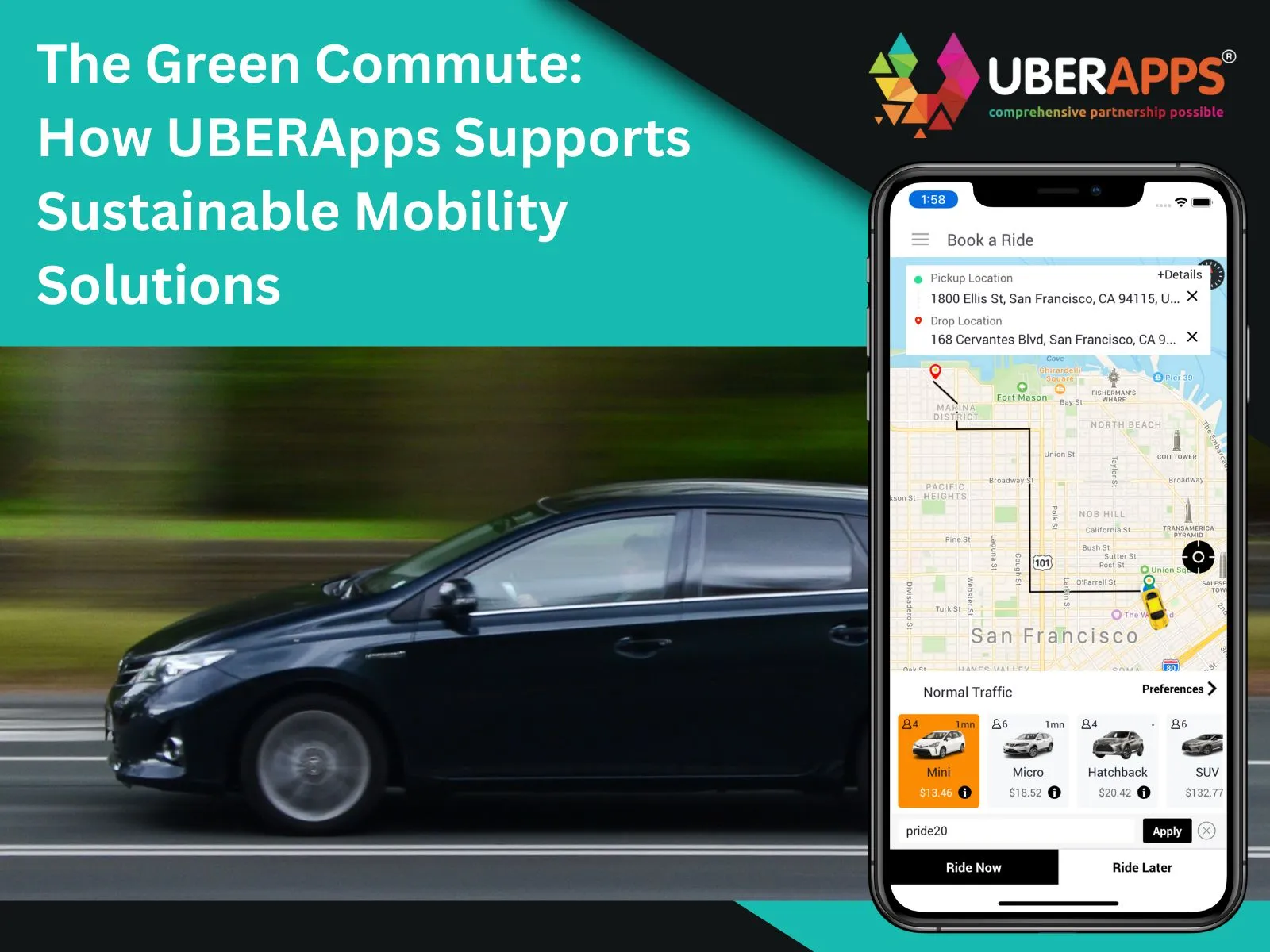
The Green Commute: How UBERApps Supports Sustainable Mobility Solutions
In an era where climate change and environmental conservation are at the forefront of global concerns, the way we commute has become a significant focal point. Traditional transportation methods, heavily reliant on fossil fuels, contribute substantially to greenhouse gas emissions and urban pollution. As cities grow and traffic congestion worsens, the need for sustainable mobility solutions is more pressing than ever. Recognizing this challenge, UBERApps has stepped up to champion green commuting practices that not only reduce carbon footprints but also enhance the overall quality of urban life.
UBERApps Technologies is leading the way in sustainable mobility by embracing green commuting practices that reduce carbon footprints and improve urban life. Committed to becoming a zero-emission platform, UBERApps introduced micromobility options like e-bikes and scooters and optimized ride-sharing through advanced algorithms. Strategic partnerships with renewable energy providers and initiatives like the Green Rewards Program incentivize eco-friendly practices among drivers. Additionally, UBERApps leverages AI for route efficiency and educates users on sustainable choices, positioning itself as a key player in the future of green urban transportation.
1The Rise of Green Mobility
Green mobility refers to transportation methods that minimize environmental impact through clean energy, efficient routes, and shared services. With rising awareness about the adverse effects of emissions, both governments and private entities have been investing heavily in sustainable transportation infrastructure. UBERApps has embraced this shift wholeheartedly, integrating eco-friendly options into its platform to facilitate greener commutes for millions of users worldwide.
2UBERApps' Commitment to Sustainability
UBERApps has set ambitious goals to become a zero-emission platform by 2040. This vision includes expanding its fleet of electric vehicles (EVs), promoting micro-mobility options like e-bikes and scooters, and enhancing ride-sharing features to decrease the number of cars on the road. Through strategic partnerships and investments in green technology, UBERApps is paving the way for a cleaner and more efficient urban transport ecosystem
3Electric Vehicles: Driving Towards Zero Emissions
One of the cornerstone strategies of UBERApps' sustainability plan is the adoption of electric vehicles. By incentivizing drivers to switch to EVs through subsidies and reduced service fees, UBERApps is making sustainable driving more accessible and financially viable. Additionally, the app features an option to specifically request an electric or hybrid vehicle, allowing eco-conscious riders to make greener choices.
4Micromobility Solutions: E-Bikes and Scooters
To address the first and last-mile problem of getting people to and from major transit hubs, UBERApps has introduced a fleet of electric bikes and scooters. These micromobility options offer a convenient and emission-free way to navigate congested urban areas. By integrating these services into the UBERApps platform, users can seamlessly plan their trips using a mix of vehicles, reducing reliance on traditional cars.
5Carpooling and Ride Sharing: Maximizing Efficiency
The concept of ride-sharing is not new, but UBERApps has revolutionized it with sophisticated algorithms that match riders with similar destinations. UBER Pool, a feature that allows multiple passengers to share a ride, significantly reduces the number of vehicles on the road. By optimizing routes and maximizing vehicle occupancy, UBERApps minimizes fuel consumption and cuts down emissions.
6Renewable Energy Partnerships
UBERApps' commitment to sustainability extends to its partnerships with renewable energy providers. The company has invested in charging infrastructure powered by clean energy sources such as wind and solar. By doing so, UBERApps ensures that the electric vehicles in its fleet are truly green, from power source to pavement
7Green Rewards Program for Drivers
To encourage drivers to adopt more sustainable practices, UBERApps has introduced a Green Rewards Program. This initiative offers incentives such as cash bonuses, reduced service fees, and access to affordable financing for electric vehicles. By making green driving more lucrative, UBERApps is steadily building a community of eco-friendly drivers
8Educating Users and Promoting Conscious Choices
Beyond infrastructure and incentives, UBERApps is focused on educating its users about the environmental impact of their travel choices. The app provides insights into the carbon savings achieved through electric or shared rides, empowering users to make informed decisions. This transparency fosters a culture of conscious commuting that aligns with the broader goals of sustainable urban development.
9AI and Data Analytics for Efficiency
Artificial intelligence and data analytics play a crucial role in UBERApps' green initiatives. By leveraging AI to predict demand, optimize routes, and reduce idle times, UBERApps not only enhances user experience but also minimizes wasteful fuel consumption. Efficient algorithms mean fewer empty rides, less congestion, and a lower overall carbon footprint.
10Challenges on the Road to Green Mobility
Despite its impressive strides, UBERApps faces significant challenges in its quest for sustainability. High costs of electric vehicles, limited charging infrastructure, and regulatory hurdles are just a few obstacles. Additionally, ensuring that electric power sources remain clean and sustainable poses a continuous challenge.
11Cloud-native Solutions
Recognizing that sustainable mobility cannot be achieved alone, UBERApps actively collaborates with city planners and policymakers to create greener cities. By advocating for policies that support EV adoption, infrastructure development, and reduced carbon emissions, UBERApps is helping shape a regulatory environment conducive to sustainable transport.
12User Feedback and Continuous Improvement
User feedback is at the heart of UBERApps' strategy. Regular surveys and data analytics help the company understand user preferences for green commuting. This information is instrumental in refining features like UBER Green, electric vehicle availability, and shared ride options, ensuring alignment with user needs and sustainability goals
13Financial Sustainability of Green Initiatives
A common critique of green mobility solutions is their perceived costliness. UBERApps has tackled this by designing financially sustainable models such as subscription-based services for electric bikes and offering competitively priced shared rides. These models ensure that eco-friendly options are not only available but also affordable for the average user.
14The Future of Green Mobility with UBERApps
Looking forward, UBERApps' vision for green mobility includes a fully electric autonomous fleet, expanded micro-mobility options, and deeper integration with public transport systems. By continuously evolving its platform with a focus on sustainability, UBERApps aims to become a blueprint for green urban mobility worldwide.
Conclusion
In a world increasingly defined by environmental challenges, UBERApps Technologies has emerged as a leader in driving sustainable mobility solutions. Through its comprehensive approach spanning electric vehicles, micromobility options, and smart ride-sharing algorithms, UBERApps' SaaS-based taxi apps is redefining how urban transport can be both efficient and eco-friendly. The company's ambitious goal to become a zero-emission platform by 2040 underscores its commitment to reducing the carbon footprint of urban commuting significantly.
By investing in renewable energy partnerships, promoting electric vehicle adoption, and incentivizing drivers through the Green Rewards Program, UBERApps is not only mitigating environmental impact but also making green commuting financially accessible. The integration of AI and data analytics has further streamlined operations, ensuring fewer empty rides and reduced traffic congestion. Additionally, UBERApps' focus on user education and transparent carbon savings empowers riders to make informed choices that align with sustainable practices.
However, the path to green mobility is not without its challenges. High costs, regulatory complexities, and the need for expanded infrastructure pose substantial hurdles. UBERApps' proactive collaborations with governments and policymakers highlight a forward-thinking approach to overcoming these obstacles. By advocating for supportive policies and investing in a robust green ecosystem, UBERApps is setting the stage for a future where sustainable mobility is not just an option but the norm.
As cities worldwide strive to combat climate change, UBERApps Technologies stands out as a visionary force, proving that technological innovation and environmental responsibility can go hand in hand. By continuing to evolve its platform with a focus on sustainability, UBERApps is well-positioned to lead the transformation of urban transportation systems for a greener, cleaner future.
FAQS
1. What is UBERApps' goal for sustainability?
UBERApps aims to become a zero-emission platform. This goal includes expanding its fleet of electric vehicles, promoting micro-mobility options like e-bikes and scooters, and enhancing ride-sharing features to reduce the number of cars on the road.
2. How does UBERApps support electric vehicle adoption?
UBERApps encourages electric vehicle adoption by offering subsidies, reduced service fees, and a Green Rewards Program for drivers. The platform allows users to request electric or hybrid vehicles for their rides.
3. What are micromobility solutions on UBERApps?
Micromobility solutions on UBERApps include electric bikes and scooters designed to address first and last-mile connectivity issues. These options provide a convenient and emission-free way for users to navigate congested urban areas.
4. How does ride-sharing on UBERApps help reduce emissions?
Ride-sharing features like UBER Pool use advanced algorithms to match passengers with similar destinations, maximizing vehicle occupancy. This reduces the number of cars on the road, decreases fuel consumption, and lowers overall carbon emissions.
5. What role does AI play in UBERApps' sustainability efforts?
Artificial intelligence helps UBERApps predict demand, optimize routes, and minimize idle times. Efficient algorithms ensure fewer empty rides, reduced traffic congestion, and a smaller carbon footprint, making urban transportation more sustainable.
Author's Bio

Vinay Jain is the Founder of UBERApps and brings over 10 years of entrepreneurial experience. His focus revolves around software & business development and customer satisfaction.

